Last week Auckland Transport released their new rapid transit map for after the City Rail Link opens sometime next year. The implication that the rapid transit network (RTN) should be fast is right there in the name, but for the avoidance of doubt, the Auckland Rapid Transit Pathway has a high-level description of the RTN of:
Rapid transit is fast, frequent, and reliable public transport. It mostly runs on its own infrastructure, uninterrupted by other traffic. That makes it an efficient way to move large amounts of people.
It sits at the core of our public transport system and will play a major part in meeting travel demand for Auckland’s growing population. It will also support congestion-free and sustainable travel.
Auckland’s rapid transport network includes the:
- northern and eastern busways
- southern, eastern, and western lines of the rail network
- Western Express and Airport Link.
The question of how rapid our rapid transit actually is, is something I was thinking about again a few week ago. These days I typically ride my bike to work – from Henderson to the North Shore at Smales Farm – and as I passed by the Sturges Rd train station I happened to come across a 12 bus, one of a handful in the morning that also happens to travel down the busway. That meant if I wasn’t riding, I could have caught it for single seat ride to work.
So I decided to track it on AT’s app. Granted, the 12 isn’t a rapid transit service – but even so, I was able to get to work, have a shower and start working before that exact bus even reached the busway. Had I caught the train and an NX1 bus instead, it would have been about the same travel time as the 12.
Most people probably aren’t comparing the speed of their commute to a bike – even though bikes, especially e-bikes, are often the fastest option at peak times for many journeys. Instead, as AT’s current Regional Public Transport Plan notes:
Aucklanders tell us that they use PT where it provides a faster travel time than cars, where it allows them to avoid the cost of parking, or because they do not have another option available to them (either by choice or necessity). Currently, our network is used primarily for trips at peak commuting times and is less well used off-peak. We want Aucklanders to use PT for all sorts of trips, throughout the day and the week. This will be particularly important as Auckland’s land use changes and the population grows, as more efficient transport options will be needed.
So I thought I’d do a bit of a comparison to see just how rapid our rapid transit is.
For now, Te Komititanga is the heart of our rapid transit system, with Britomart on one side and the Lower Albert St Bus Interchange, the terminus for the NX1 and WX1, a short distance away on the other. So how long does it take to get there on public transport from each of our rapid transit stations – and how does that compare to driving?
A few notes about this comparison:
- For PT,
- For trains I’ve used AT’s timetables and for buses I’ve Google Maps as it feels more accurate than AT’s timetables.
- I haven’t taken into account any time it would take to get to stations or wait for a service.
- For driving,
- I’ve used Google maps to indicate a travel time. This is represented as a range, e.g. 20-40 minutes.
- As with PT, I only assumed someone is driving starting from the station so actual times may vary. I also haven’t accounted for the need to find a car park in the city and walk to your destination from that car park.
- For each station, I’ve done this analysis twice: once as if I was arriving at 8:30am on a Wednesday for the peak time component. and I’ve also looked at 1pm to get an off-peak comparison.
Northern Busway (NX1)
The NX1 is the busiest and most successful bus route in the country, and it’s even busier that most of our train lines too. In the chart below, you can see that at peak times, buses are generally the fastest way to get to the city and even off-peak they are competitive. As such, it’s not uncommon to see well-used buses at all times of the day.
Interestingly, the bus travel time Google suggests is faster than the AT timetable suggests – from personal use, I can concur that AT’s timetable has always felt slow.
While buses are competitive now, they could still be faster – and the biggest opportunity to do that would be to speed up dwell times (this will become a common theme in this post). Double deckers can be much slower at stops, due to needing to wait for passengers using the stairs.
So faster stops could be achieved with changes like all-door boarding, and possibly changing to using articulated buses. Many modern articulated buses have three or even four sets of doors to facilitate faster turnover at stops, and can carry more passengers than a double-decker. The downside to articulated units is they take up more space at bus stops, so the implications of that need to be worked through.
Western Express
The lack of dedicated infrastructure means that unlike its northern cousin, Google suggests the WX1 takes longer than AT say in their timetable. That’s because the buses are more subject to congestion than the NX1 is. At peak times the service is competitive – but off-peak, it isn’t.
The long-term solution here is of course a proper busway. While many years off, that would provide the improved speed and reliability this route needs.
Southern Line
At peak times, the Southern Line does pretty well compared to driving at peak times – but off-peak it depends on where you are along the line. Most ridership tends to come from the more southern stations, but they’re also the ones that are the least competitive compared to driving during the off-peak.
Eastern Line
The Eastern Line is more competitive than driving at peak compared to the Southern Line, but like the Southern it is more of a mixed bag off-peak – which is not surprising given they share stations.
Western Line
The Western Line is perhaps the most out-of-line with what we see above. Where most of the examples above are time-competitive at peak, and in the middle of the range for driving off-peak, the Western Line is only competitive in the middle of the range at peak, and is well above it off-peak.
This is due to two main reasons: 1) drivers essentially get a shortcut compared to the rail line, thanks to the causeway along SH16, which mainly benefits people near the outer stations and 2) the Western Line currently takes a circuitous route via Newmarket. The latter is something the CRL will solve.
The CRL is expected to take about 9 minutes from Maungawhau to Britomart, about half the time that it currently takes. So I’ve added an expected travel time with the CRL to the chart here too. As you can see, it helps to make the Western Line much more competitive to driving, both at peak and off-peak.
Speeding up train services
Even without the CRL, our trains are terribly slow. As I’ve highlighted before, comparing the average speed of our rail lines to other similar systems, you can see we’re clearly below the curve.
It wasn’t meant to be this way, either. The travel times required by AT/KiwiRail and estimated as achievable by the train manufacturer prior to electrification are in line with the general trend you can see below.
There appear to be two main things holding us back from achieving the average speeds originally expected.
- The quality of the tracks – As has been well documented now, Auckland’s rail network is/was in a terrible state due to a lack of proper maintenance for decades, the result of not enough funding and attention towards improving things. That has changed, as evidenced by the huge amount of disruption we’ve seen over the last five years as KiwiRail finally starts to get the network up to a modern state. Doing so will allow most of the temporary speed restrictions (TSR) to be lifted, thus improving travel times. Last year it was reported that these TSRs were causing up to five-and-a-half minutes of delays per service on the Western Line.
- Dwell times – These have been a regular bug-bear of mine for over a decade now. A few days before I raced the 12 bus, my bike was having some maintenance done so I caught the train. Along the way I took the opportunity to time how long trains were stopping for, to see if there’s been any improvement over the years. There hasn’t been – and at most stations (excluding Newmarket) the dwell time continues to average between 45-50 seconds, which is 15-20 seconds longer than it should be based on typical practice.
Fifteen seconds might not sound like much, but if you’re travelling further, it can add up quickly – and for someone travelling all the way to Swanson could add as much as five minutes to a journey. What’s more frustrating about dwell time is it isn’t even directly about the passengers, as the doors themselves are typically only open for about 20 seconds. The other 25-30 seconds is things like waiting for the doors to open once the train has stopped, waiting for the ramp for the low-floor section to deploy, and the process train managers go though before the train departs. That process could have and should have been improved by now, but it hasn’t.
Combined, that’s more than 10 minutes of travel-time savings for some of the further out stations, which would bring the travel time close to those original expectations. So, I’ve done some versions of my charts to show the combined savings of the CRL and these additional travel-time improvements.
As you can see, with both the CRL and the other improvements to travel times, even off-peak the Western Line starts to look much more attractive.
Is that enough to put the rapid back in Rapid Transit?
This post, like all our work, is brought to you by the Greater Auckland crew and made possible by generous donations from our readers and fans. If you’d like to support our work, you can join our circle of supporters here, or support us on Substack!
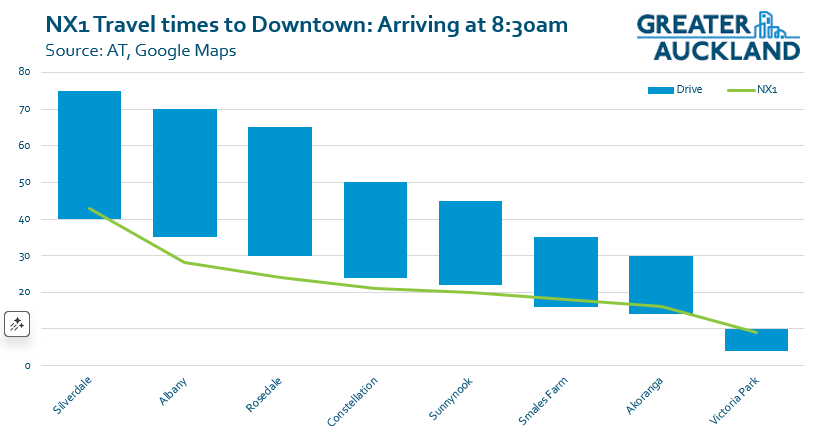
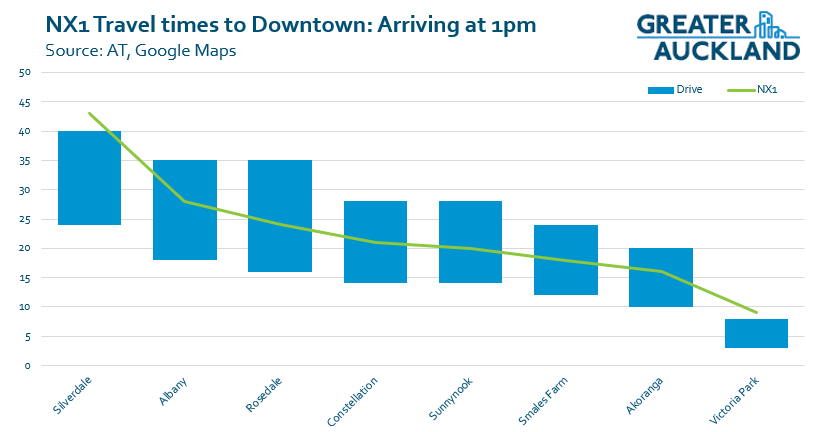
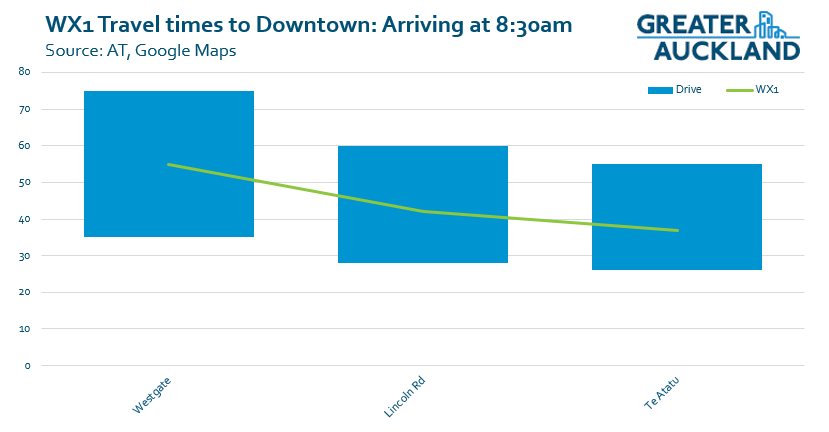
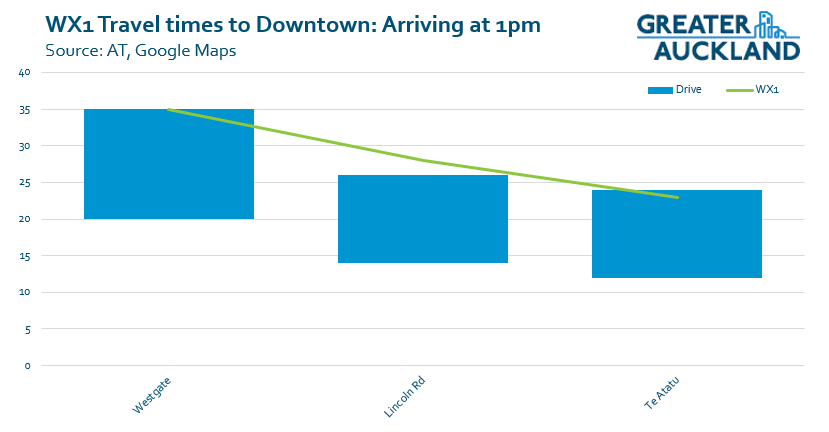
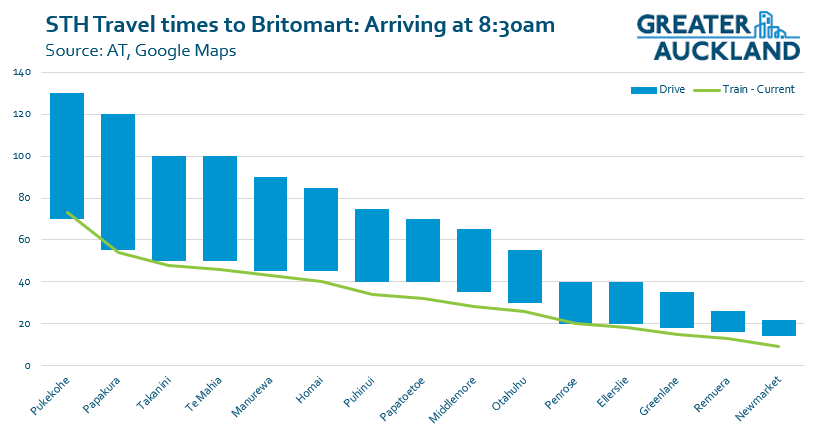
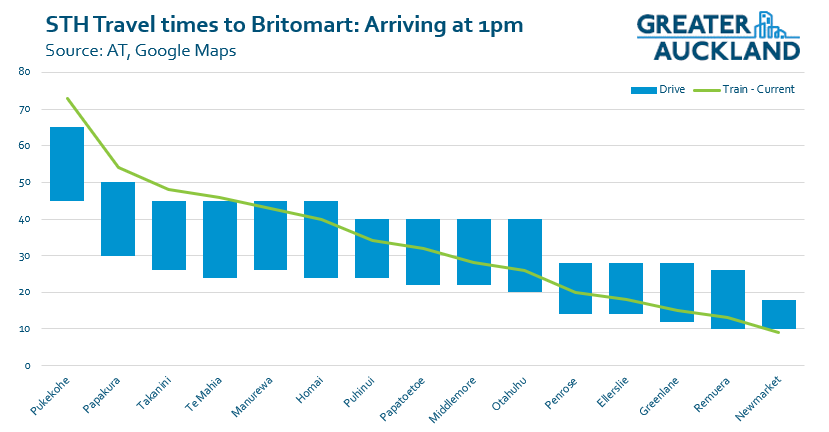
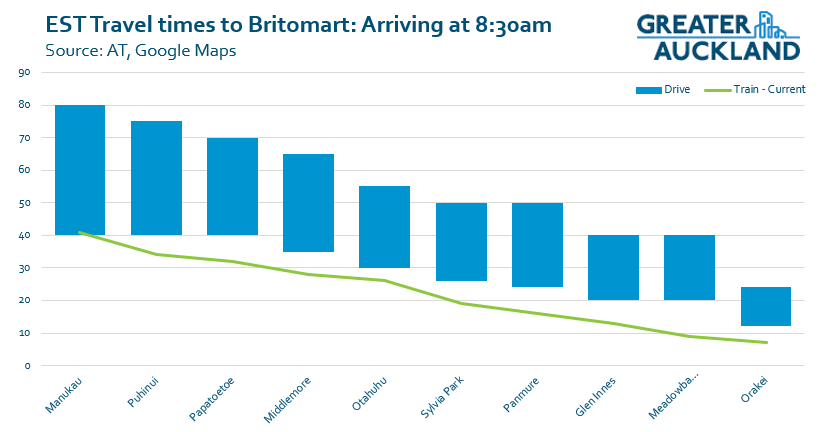
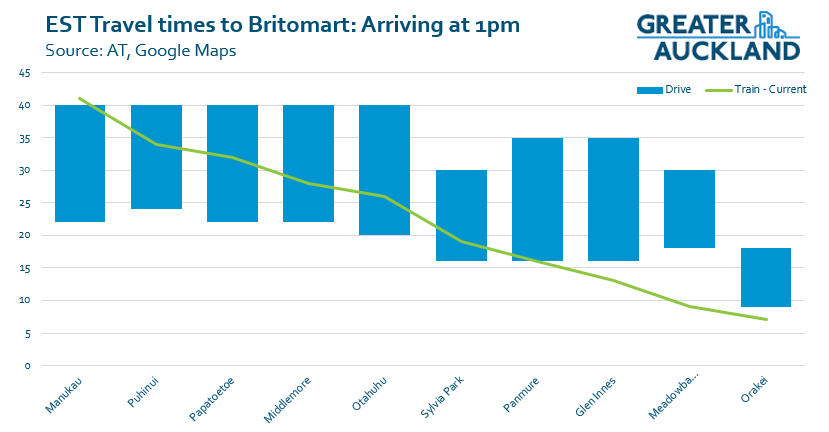

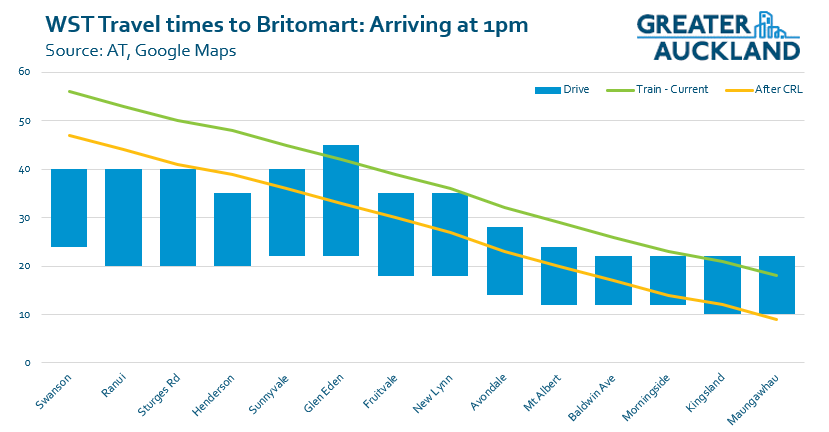
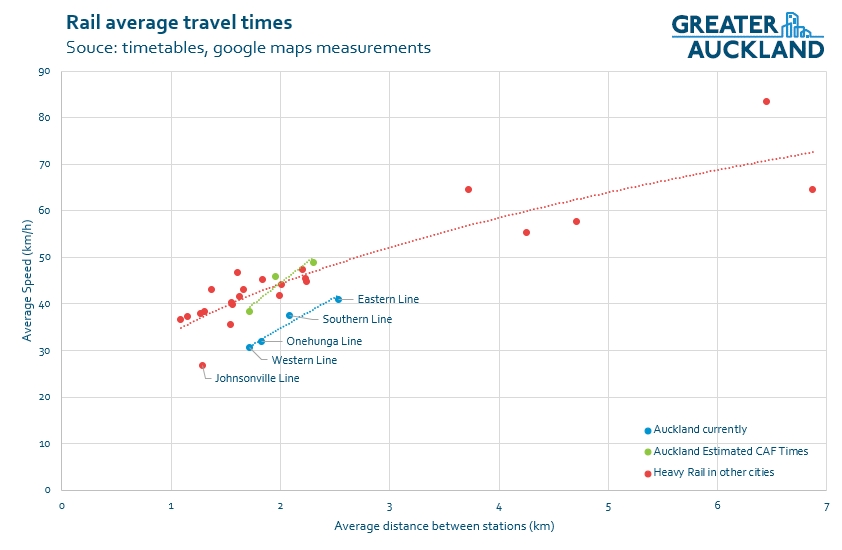
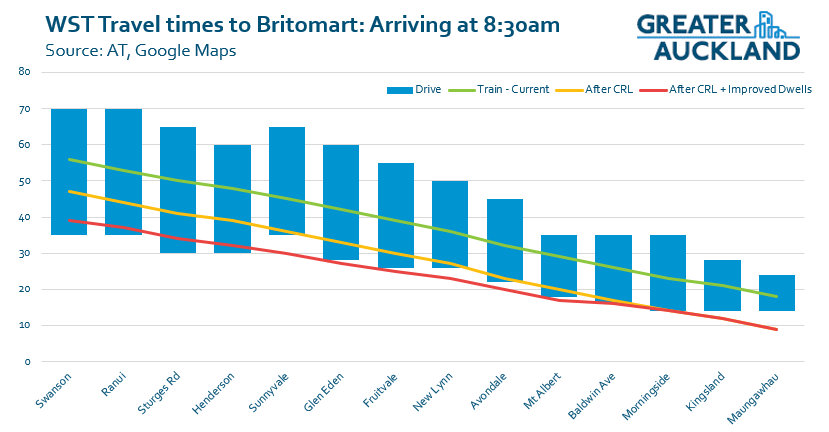


 Processing...
Processing...
inb4 Anon comes barging in with their nonsense about how “frequency doesn’t matter only speed” and “heavy rail can immediately accelerate to 110km/h regardless of station spacing or line curvature”.
actually knowing their cultish heavy rail devotion they might think the auckland rail network can just start operating at full speed tomorrow. i wouldn’t trust someone who thinks the Avondale-Southdown line has “already been paid for” and “will only cost $100 million to lay tracks down” to have good critical thinking skills.
The only problem with Avondale to Southdown is it goes from Avondale to Southdown.
I’d rather they make A-S a busway if the alternative is Kiwirail building heavy rail on it in 2055. Because that’s their timeline under their 30yr plan…..
It goes from Southdown to Avondale as well, so double the value for money.
I’m glad you’re hating every word of it! I’ll be coming back for more! Aucklands really needs more Busways, Heavy Rail corridors particularly to&from Auckland CBD in next 10 years!
Hope something gets done about our current corridors, congestion getting worse and building more roads isn’t going to break overly congested bottlenecks to & from Auckland CBD. It’ll produce the alternative of bypassing the CBD but won’t reduce congestion in & out Auckland CBD area.
yes, i do dislike blatant lies and people who are so idiotic they deny the laws of physics.
Heavy rail trains can’t accelerate to 110km/h then decelerate back to 0km/h in 800m. It’s physically impossible.
Certainly not true, it won’t accelerate fully immediately, due to heavy rails weight. Once accelerating to full 110 km/h, starts the process of gradual smooth deceleration within duration of 1 mins between each station spacing.
again, you are so stupid
the heavy rail trains can only accelerate up to 80km/h before they have to start decelerating for an 800m station spacing, and even then it only saves a second compared with a max speed of 70km/h, 5 seconds for a max speed of 60km/h, and 10 seconds for a max speed of 50km/h.
https://www.greaterauckland.org.nz/wp-content/uploads/2018/04/Rail-Speeds-800m.jpg
which completely debunks your useless biased arguments about light rail being too slow. modern light rail vehicles also accelerate and decelerate 30% faster than auckland’s heavy rail trains (1.3m/s ² for LRVs vs 1m/s ² for the AM class trains) which makes that difference even more insignificant.
and again, since your little brain can’t seem to understand this, you have to climb 1-2 minutes to get out of an underground station just to get to street level. light rail stations are already at street level. that means you get quicker from the station to whereever you need to go.
sorry not sorry, light rail is objectively far better for dominion road mass transit than some overengineered hamstrung heavy rail tunnel with expensive stations too close together for the trains to use their maximum speed.
oh and by the way Anon, here’s proof that even running at street speed limits, light rail down Dominion Road would still be quick and better than buses. 20 minutes from Waitematā/Britomart to Mt Roskill. And this is using the slower acceleration rate of the AM class heavy rail trains; since light rail can accelerate and decelerate 30% quicker these times would likely be a few seconds shorter.
https://www.greaterauckland.org.nz/wp-content/uploads/2018/05/Rail-Travel-Time-Model-LRT.jpg
And yes, despite your deluded mind the reality is light rail can have traffic lights programmed to always let the trams go through without ever having to stop.
Or, if you’re constantly assuming the worst travel times and slowest speeds for light rail, it is only fair to assume the worst travel times and slowest speeds for heavy rail in comparison.
Idk why the AMs were advertised with “user operated doors” when they only open maybe a fraction of a second faster when u press the button (and is pointless for the accessible middle doors)
Feels like AT is incredibly stubborn to make sure the dwell times are consistent, even if it means it’s slow
Dwell times were extended,early on, by 10/15 seconds do to the deaths and injuries caused by the increased train-to-platform gap made necessary so the new longer carriages could clear existing curved platforms. People rushing, but failing to board, would more easily slip into this wider gap and, as train moved away immediately upon the closing of the doors, would be injured.
No where l have been in the world (62 contries) has their trains had such gaping gaps nor have required an automated step to be deployed for wheeled access, an obvious attempt to mitigate this recognised design failure (among many others). We continue to purchase more of these same units, l see.
You haven’t been to Australia? Melbourne has gaps you could lose a child in, and if you want to get a wheelchair onboard you have to wait for the driver to get out of the cab with a folding ramp.
The Onehunga Line is definitely not rapid transit the opposite in fact. Onehunga Bus (30) services every 15 minutes is twice as frequent than the Onehunga Line. Fix the Penrose transfer and run the Onehunga Line as a higher frequency shuttle for transferring to the Southern Line. Would significantly increase patronage & fill up the empty Onehunga train station park & ride carpark.
I think you would need to double track it too, wouldn’t you…
Double track on point in the middle of the line. Trains could leave either end at the same time and cross over on the short double tracked section in the middle.
Passing loops on single track rail lines are normal, the only additional consideration here is timing so passengers don’t complain about a wait.
Yes, it could operate almost like the cable car in Wellington. Two trains going backwards and forwards is a reasonably simple pattern to keep in sync with a passing loop in the middle.
Make it light rail? Could they fit 2 tracks in – looked like lots of room last time I used it.
Wow – Pukekohe drive time 8:30am to Britomart – 100minutes +/- 30min or 70+min for the train, and similar for the 5pm return trip. What a waste of human life !!
While its pleasing to have a train service to complain about, Auckland truly is the city of snails.
Does google publish its isochrones ?
I think one of the main advantages to public transport is its consistency. I know how long it takes me door to door and there’s practically no variation.
The same is not true for driving. People seem to get very agitated about the variability of travel times.
I agree. It is the variation that causes stress and means you have to go too early most of the time.
When there is such. Using WX is one so called rapid transport where if there is congestion the arrival time is guesswork.
Sometimes the bus cruises through and we arrive as per timetable, sometimes it takes 50 minutes. Good luck keep a job under those circumstances.
You cant plan work or arrive on time if you use the current WX during congestion times.
Car travel time on SH16 is probably less reliable than WX1 currently. The only prospect is a decent busway, which keeps getting pushed back whenever the car enthusiasts are in government.
There is another major cause of delay to western line trains, which is the practise of holding them for several minutes at Newmarket so they can be passed by southern line trains. The numbers of passengers who respond to this by changing trains – and the number who don’t – illustrate the greater importance of travel time than of single seat travel to many of us, but not all.
Second that, very annoying, especially if the Southern line train closes its doors just as you get off.
It’s not super rapid, in the afternoons I travel from lower Queen St to Howick. If I time leaving work to catch a train, and am lucky with a bus connection at Panmure, I can do it in just over an hour. Most days I cycle, and it’s an entirely consistent 1 hour 6 minutes. I borrowed an e-bike for a week and it was 54 minutes.
Trains need to gohit higher top speeds with less delays, getting rid of the choke point at Britomart next year will help. As mentioned, each stop just takes too long. Every KM of bus lane helps, also we need more bus priority at junctions and lights.
It’s not awful, either cycling or PT are faster than driving at peak times. Off peak and weekends, driving is just so much nicer. I can get to Kingsland in 30 minutes in the car, versus 90 on PT.
As a person, with only my legs and an ATHOP card to move me about, I personally use Public Transport because I feel safe inside a large vehicle, and my two children are kept safe inside with me, while I do not need to distract myself with the silly activity of driving.
The reliability of the network is the most important part for me, I have spent much of my time calculating bus transfers for school pick ups and drop offs, and have made them as continuous as possible.
As a city that has grown outwards, rather than the internationally traditional upwards, we are overly reliant on our transport network.
The only way to improve our public transport network is by removing space from the private motor vehicle driving persons, who have not thought about retiring from the mindless activity of driving.
It is all about space. Not outer space. Not the moon. Space. Persons can live on top of each other; with well designed apartments and community spaces, persons will prefer to live in apartments. This is the key to unlocking our city. We can keep improving our bus network, although light rail would be preferable, we can keep complaining about the commute. But if we all live in apartments, we start to reduce the need for garages, and free up existing space that is wasted with private motor vehicles.
This is think bigger than the big, but for how long will we sit around letting seventy to eighty year old white men tell us that they can FIX our city? Why didn’t they FIX it when they were younger?
bah humbug
I’m pretty data-literate but it took me a while to figure out exactly what these charts were meant to represent.
In the future could you use more standard graph methods?
Took me about 10 secs. These are great maps for the normal user I would expect.
If you screen out everyone who won’t spend the time to grok non-standard charts, quite a bit of the audience is lost. Better to improve things than to set a bar needlessly.
Seoul is constructing three new subway lines with operational speeds of 180 km/h. Although none of them are yet complete, the first one (GTX-A) has two sections in service.
https://en.wikipedia.org/wiki/Great_Train_eXpress
Yes, here’s a new good video on their whole PT system in general, plus general good tips for good metros etc.
https://www.youtube.com/watch?v=aLKN_Rmb39I
I have to disagree about dwell times being an issue on rapid network buses. The amount of time a Northern Express bus spends loading and unloading passengers at each station is totally negligible, and using articulated buses instead would only save about ten to fifteen seconds MAX per stop — and even adding this together over the whole route wouldn’t account to much since there are so few stops on those routes.
On trains it’s much more relevant, because they take so long to slow down, so long to open the doors, so long to check everyone is out of the way, so long to close the doors, so long to speed up again… None of this is the case with buses.
The only thing holding back the Northern Busway is joining general traffic over the bridge and into the city centre.
Yes, last point obvious from Matt’s great charts. Time for bus lanes on the bridge.
ppl on the upper deck do seem to have learned to start making their way to the stairs – or even going down the stairs – while the bus is still moving pulling into a station.
there were that spate of injuries from elderly ppl falling down double decker bus stairs back when they were being rolled out across Auckland, if i remember right.
in my experience boarding is what takes the longest with the NX1/NX2 buses. Queueing up single-file to tag on through the front door. Multi-door boarding, and/or off-board HOP tag posts on the platform like with train stations could alleviate that.
In the Wairarapa, Metlink have tag on/off posts on footpaths for when rail replacement buses are in operation. If they can manage them for temporary situations, I do wonder why AT aren’t using them on the busways.
That’s all very good. But its the time it takes from your front door that counts. At alot of bus stations you can’t get a park, so what then? Great service but you have to get to it to use it. Auckland weather is also to fickle to stand at a unsweetened bus stop.
How do they sweeten bus stops? lol
let me introduce you to the wild unearthly concepts of walking, wearing a raincoat, or carrying an umbrella.
You can’t stress too strongly that a competently managed urban rail service should have an off-peak minor station dwell of no more than 25 seconds.
In Sydney, with large (1.8 metre) plug doors and 2-person crews, we typically have:
train stops 0, doors start to open 1, doors are fully open 5, handling passengers say 5-17, doors start to close 17, doors are closed 21, train starts 25.
In Melbourne, with driver-only operation and faster 1.4 metre doors, an off-peak minor station dwell is often around 20 seconds (drivers check for safe closure by looking at big video screens at the end of the platform next to the cab).
I see no merit at all in the idea mentioned in another comment that dwells have to be longer as a safety measure because of platforms with wide gaps.
The train can move if and only if the doors are closed and the driver has checked that the situation is safe – which should take no more than 5 seconds, as noted for Sydney.
If the situation *is* safe, there’s no point in waiting any longer.
In fact waiting longer could be counter-productive – those extra seconds are just more time in which an arriving passenger might try to force open the door of a train that’s about to start.
Incidentally, the same logic applies at level crossings to the buffer between ‘gate fully down’ and ‘train enters the crossing’. The buffer obviously needs to be long enough for vehicles to clear the crossing; but there’s no point in making it any longer, because that’s just extra time in which an impatient motorist might try to drive around a closed half boom.
Yes, Wellington with a TM having to close their door separately still does it in 30 seconds.
I personally think dwell times on the NX buses aren’t a big issue. They stop for about 30-40 seconds and they’re up and off again. Since there’s so few stations compared to the train lines, and a high average station spacing, the dwell times don’t stack up as much. The biggest wait is usually if there’s a big bus sausage blocking the entire platform, and the bus has to wait for a spot but even that’s only an extra 15 seconds at most. Switching to articulated buses wouldn’t have that much more benefit for the busway since they take up much more room than a double decker with about the same capacity, meaning the current sixty-ish buses per hour all coming in big clumps would find it harder to cope with the effective reduced platform length. An important thing to note with all door boarding is that buses have smaller doors than trains. Drivers already do all-door boarding at Albany (and Constellation sometimes), but all door boarding could clog up the hordes of students getting off at Smales Farm or Akoranga, cancelling out any dwell time savings it could get.